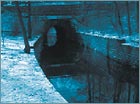The city of Cleveland, Ohio, is adding a new runway to its airport. Unfortunately, that expansion will ruin a picturesque urban park sixteen miles away-all in the name of environmental protection.
To expand the airport, the city has to fill a ravine and drain 88 acres of wetlands located on the airport property. Because of the nation’s “no loss of wetlands” policy, the city had to obtain approvals from the U.S. Army Corps of Engineers and the Ohio Environmental Protection Agency. To persuade the regulators to approve, Cleveland came up with a plan to mitigate the loss by adding wetlands and “restoring” thousands of feet of streams and rivers elsewhere to a more environmentally sound condition. Twelve thousand of those “restored” feet will belong to the Doan Brook, a small stream that flows through Cleveland’s Rockefeller Park on its way to Lake Erie.
But Doan Brook doesn’t need restoration-at least not that kind.
Rockefeller Park is a stunning 200-acre public space, designed and built in the early 1900s. It lies in a ravine, surrounded by some of Cleveland’s poorer neighborhoods that are only now making a comeback from the riots of the 1960s. The brook’s path through the park is paralleled by a hike-andbike trail dotted with enormous flowerbeds. It winds through a unique Cleveland institution, the Cultural Gardens.
Since early in the last century, various ethnic groups have sponsored gardens and memorials designed by prominent American and European landscape architects. These gardens-twenty-two at present-have flowers, sculptures, memorial arches, fountains, and other striking and original features. The German Garden has a statue of Goethe and Schiller; a monument in the Hungarian Garden commemorates Franz Liszt. As the brochure of the Cleveland Cultural Gardens Federation, a local nonprofit organization, explains with more than a little local pride, “The Gardens were conceived for the purpose of honoring and celebrating our cultural diversity and to symbolize peace, brotherhood and harmony among all people of all nations. . . .”
Doan Brook emerges from buried pipes and is “channelized,” or lined with vertical stone walls, through the park. The brook’s path through the park is not a straight line, but a winding channel, following Martin Luther King Jr. Drive north from the University Circle neighborhood to Lake Erie. Before reaching the lake, it flows into another buried culvert, from which it eventually reaches the lake. The walls prevent the stream from flooding and damaging the park and the road. They also contribute to the park’s atmosphere as an urban park, creating an attractive complement to the road.
Rockefeller Park is a park designed for people, not for nature. Its gardens are formal in style and feeling. When we build parks today, we usually build them differently-no channelizing, no stone walls, no sign of human impact on the environment. This park, and the gardens, were built at a different time, when a stream lined by beautifully cut and shaped stone walls was a thing of beauty, not an environmental crime. Modern environmental fundamentalists have no room for such creations; they see them as evil. Preserving a mix of our heritage ought, however, to at least be an option.
To environmental nannies, this park is simply not natural enough. The graceful stone-lined channel will be replaced with a gravel bed, and trees will be removed to make room for the new, wider stream bed, which, in theory, will support fish. Five of the twenty-two cultural gardens will lose land to the “restored” brook. The value of the park as a place for celebrating humanity will be sacrificed to the ideal of a “natural” setting.
Like many public spaces, the park and the gardens have seen good times and not-so-good times, as when Cleveland’s fiscal crisis in the 1970s drastically reduced city spending on park maintenance. The gardens have benefited from the efforts of the Cleveland Cultural Gardens Federation, in addition to countless volunteer efforts by local ethnic organizations. They also enjoy strong community support. When a number of flower plantings were vandalized and stolen this past year, volunteers turned out to provide the labor and funds to replant.
This community opposes the “restoration” of Doan Brook. “The whole idea of restoring water quality and having a variety of fish swim up and down the brook is nice,” George Parras, the president of the gardens federation, told a (Cleveland) Plain Dealer reporter, “but they are overlooking what will happen to the park itself. What we don’t want to see is them take a highly structured park, which is very beautiful, and turn it back into a natural stream.”

The decisions were made by regulators who aren’t from Cleveland. Ohio EPA bureaucrats from Columbus and federal regulators from Washington, D.C., have dictated to the Cleveland area the terms and conditions under which the city will be allowed to expand the city-owned airport. Those bureaucrats don’t care about Rockefeller Park and the Cultural Gardens. Even if they did, they couldn’t act on that concern because the statutes the agencies enforce don’t make provision for anything but restoring wetlands. Whether Cleveland residents think that expanding the airport is such an environmental calamity that it should require acres and acres of mitigation is not relevant. Whether Clevelanders prefer their cultural gardens and parks as they exist now is irrelevant as well.
We can draw a few lessons from the tale of Doan Brook and the Cleveland airport. If the park were privately owned, the takings clause of the U.S. Constitution would at least make the regulators think twice before harming the property; the city would have to pay for any damage it caused. If environmental regulations were handled by appropriate local authorities, the fate of the park and the brook would be a matter for Clevelanders to decide for themselves. Federalism would improve decision making.
But perhaps a more important lesson is that our current fervor to “restore” our environment to what it was before humanity touched it has a real cost. There is more than one way to experience nature, and human-centered approaches can create beauty and serenity. Cleveland’s Cultural Gardens and Rockefeller Park illustrate how communities can transform their environment to improve their lives.
Over the past century the peoples of Cleveland came together and created a unique cultural resource out of a swamp. These things may not matter in Columbus or Washington, but they matter in Cleveland. Getting a swamp back in exchange seems a poor trade indeed.
Andrew P. Morriss is a PERC senior associate and Galen J. Roush Professor of Business Law and Regulation at Case Western Reserve University School of Law in Cleveland. He lives in Lorain County, Ohio, just down the road from another “restored” wetland built to mitigate the airport project’s impacts.




